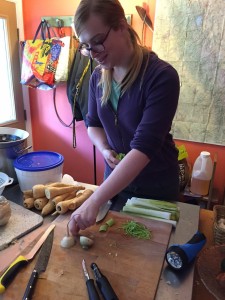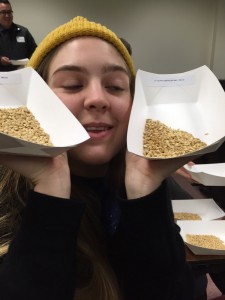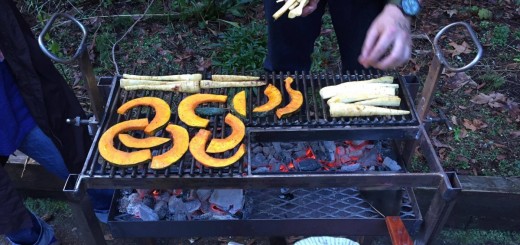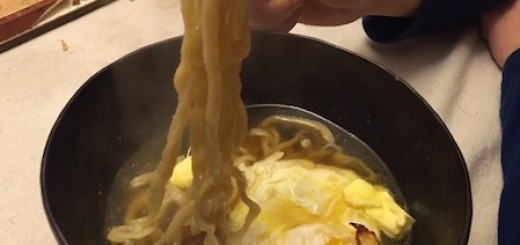What We Learned About Cooking for Groups
Above from left Ze Wei, Daniel Saunders, Lydia Hammond, and Bonnie Zion (photos by same)
We chose to make chicken ramen for our first group project. We thought ramen would be a popular, affordable, and a doable entry point into cooking for our classmates in the Terroir program at Evergreen. We were not wrong, though it ended up taking hours of practice and research to make decent ramen noodles. We also realized that packing up all the kitchen stuff we needed and driving it to campus was totally possible. But unpacking, cooking, serving, and cleaning up in a 1.5 hour lunch break was very difficult and put severe restrictions on what we could cook.
Ramen is essentially a fast food, hot broth, quick-cooking fresh noodles, some garnishes and you’re off to your happy slurping place. Sure, there’s plenty of preparation -the broth alone had to simmer for 10 hours- but we got all this done before coming to campus for our first meal. Nonetheless, it turned out that heating up the big pot of broth and the pots of water necessary to boil noodles took almost an hour on the weak electric stove we had access to. By the time our noodles were boiling our time to serve the ramen was cut down to 20 minutes… So much for sitting down and talking with our classmates about the ingredients and the cooking process. From this we learned that you can (and should) do everything you can to expedite your kitchen work, but plan for things to take a bit longer than they should. Plan for things to go wrong.
After working within this narrow time window for the on campus ramen meal, we decided we could cook more interesting food if we had more time and space. We decided to do the next meals at private homes and invite groups of classmates over.
With our second meal we decided to really stretch our creativity by building the menu around ingredients we found on a foraging trip to Duckabush River Public Tidelands in the Hood Canal part of Puget Sound. We came up with an interesting menu including oysters served in a cloud of tea smoke, and soy sauce cured egg yolks over rice with pickled clams and seaweed (see our post on the Meroir dinner recipes). There was lots of prep but not much last minute cooking necessary for this menu. Of-course, things still went wrong. We had a hard time lighting the charcoal that was supposed to cook the oysters and smoke the tea, the egg whites in our cocktail weren’t fully incorporated so a few people had snot like clogs in their drinks. It was the material of dinner party nightmare stories. Luckily the desert, Chinese black tea ice cream with candied tea leaves, was delicious. That’s all anyone remembers anyway, right? Please say it’s true?! We learned a lot from this meal. First, the more moving parts you have in your menu, the longer it takes to practice and get right and the more difficult it is to get right the first time. Second, just because all your guests have arrived doesn’t mean you have to put all the food out right away. Let people hang out and take as long as you need to cook the food right. We rushed the cocktail and what happened? People were slimed! Now we remember that drink as the Snot-tail.
This Meroir meal also showed us something about cooking meals with taste of place in mind. There are two basic ways to prepare a taste of place meal. The first way is more common. You find local ingredients and use them to prepare a crowd pleasing favorite like roasted seasonal veggies, ramen, or fried chicken. While these dishes are made with local ingredients, they could be made with local ingredients in many parts of the world. There is no distinct unique taste of your place. Plus you can season these grilled veggies with sherry vinegar from Spain, or dust the fried chicken with Sichuan peppercorns from China. You end up with this interesting paradox of local ingredients used to create dishes that could be flavored with spices from around the world, prepared with techniques from any of a dozen cooking cultures. The second approach to a Terroir laden meal is to base it on flavors that are distinct to your place. You go beyond using locally grown leeks and carrots and embrace the wild plants as your seasoning. Where we live at the south end of the Puget Sound, this meant cooking with seaweed and shellfish. This kind of cooking, where local flavor not just local ingredients is the focus, is harder to do. We enjoyed the challenge of designing a menu around wild flavors of the Puget sound, but, you will notice, for our final meal we went back to a crowd pleaser: the Sichuan pepper fried chicken inspired by a dish at Mission Chinese in San Francisco.
The fried chicken meal went very well. Even though the cooking took longer than expected, when people arrived we kept in mind what we learned from our previous mistakes. We stayed calm and continued cooking until everything was just right. In the meantime we served Oolong tea and told them about what went into making the food. Giving ourselves time to finish cooking everything was a huge boon. We even started cleaning up the kitchen a bit while the chicken was still frying. (It turns out cleaning some between courses can be very helpful so that the counters are clear to take more dishes after desert). When the chicken came out it was much loved. One classmate said it was the best chicken, fried or otherwise, that she had ever had.







